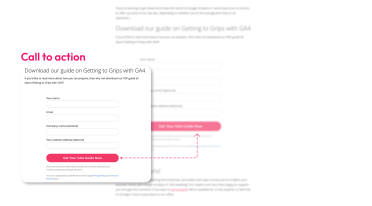Beyond clicks: The power of CRO for boosting your business
In today's digital age, website clicks hold immense value as each click could potentially lead to a sale. However, to fully capitalise on your website's potential, it's important to go beyond clicks and to focus on optimising your visitors' experience from a Conversion Rate Optimisation (CRO) perspective.
What the heck is CRO we hear you ask?
CRO is the process of improving the percentage of website visitors who take a desired action, such as making a purchase or filling out a form. By focusing on CRO, you can increase the effectiveness of your website and turn more of those valuable clicks into actual customers.
A good CRO campaign not only saves time, money and efforts by making use of existing content, but also explores new growth strategies, helping you to understand your website’s usability better while giving customer behaviour insights and suggestions for making your UX meet your ambitions.

Why is CRO so important?
- CRO increases revenue - Improving your conversion rate means more of those ‘clicks’ become customers, leading to an increase in revenue over time.
- CRO improves User Experience (UX) - Optimising your website for conversions means you’re taking more consideration into your website users and their specific needs and expectations, and therefore making alterations to enhance the way data has informed you that they interact with your site. In turn, this will improve the UX of your website, leading to increased customer satisfaction and loyalty ensuring repeat business and referrals.
- CRO provides valuable insights - Through carrying out CRO tests, you gather valuable data and information regarding your audience and their behaviour. This enables you to make any necessary changes to other elements of your business, such as product development and customer service.
The anatomy of CRO
Landing pages
Landing page design is the first and foremost element that defines the usability and success of a website. A landing page is where a visitor “lands” after they click on a link placed within one of your marketing campaigns. Designing your site with the end goal in mind and making it more aesthetically pleasing and easy to navigate guarantees more traction! Your landing page should be relevant and answer the needs of your audience.
Copy
Here you need to consider what words will ‘hook’ your users. What is going to be engaging and persuasive? Your headlines need to be formatted and written correctly to be concise, digestible and informative. Consider the tone in which you're addressing customers, how do you want to communicate your business's brand and character?
Call to actions
A call-to-action (CTA) is a request or call for customers to take the desired action. The stronger and clearer the CTA, the more leads it can generate. This could include:
- A form subscribing to a newsletter
- Booking a slot in a webinar
- Making a purchase


Site structure
Your site’s structure must focus on building an experience that’s easy to navigate. Site structure, at its core, is a diagram of how different pages of your site interact with each other. If this process is fluid then your users will not have an issue navigating through your site. But, if it’s unstructured, they’ll be lost in the process; ultimately abandoning your site and leading to lower conversion rates.
Forms
Forms are crucial, optimising these important customer touch points can help to improve the conversion rate. Generally, try to keep the number of fields as low as possible, make putting in data, making payments and creating passwords simple, making them work across a variety of devices and make submissions one-click if you can.
Speed
Page speed directly affects the experience of a user, the conversion rate of the site, and its ranking on the search engine. Users will not wait around for a page to load!
So what are the best practices for CRO?
We’ve broken down how your business can begin optimising their website’s conversion rate into simple steps so that you can easily implement them and start driving sales.
- Define your users goals - Ask yourself what it is you want visitors to do, whether that is make a purchase, sign up for a newsletter, etc. Once this is defined, then you can better identify what aspect of your website experience and user journeys require improvement.
- Analyse the data - Using tools (such as Google Analytics and Hotjar), look at what both qualitative and quantitative data you have that will enable you to make informed decisions about your CRO. Metrics like bounce rate, time on site, and entry and exit points will help you see what areas you need to improve. You can also use customer feedback to see how individuals felt when they experienced your site.
- Test, test, test - By conducting questionnaires, mapping the user journey and a variety of tools (like Screen Readers) experiment with different changes and how these impact on the user experience and your conversion rate. What changes show to have a positive improvement and what ones show little to know change?
- Continue to track - As you repeatedly make changes and test, track the results and use them to inform your next steps. This will be ongoing and you should always be testing to look at ways to improve your website's usability and conversion rate over time.
Consolidation time
By focusing on Conversion Rate Optimisation you can make the most of your existing website and maximise the results from your existing traffic and marketing efforts. We hope this has got you energised to better understand your customers, their behavioural patterns, and what they want from your website experience. Using data and tracking helps to inform strategies for the future, improving your businesses ability to keep up with competitors.. Many companies ignore the importance of CRO, do not be one of these! Does this all sound daunting? Don’t have the time or the means to start optimising your site's conversion rates? Why not get in touch with our marketing masterminds and see how we could potentially help you to convert more of that traffic into revenue for your business.

